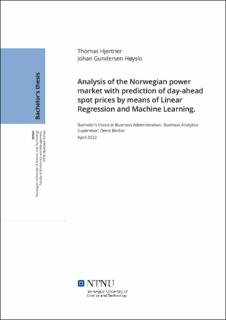Analysis of the Norwegian power market with prediction of day-ahead spot prices by means of Linear Regression and Machine Learning.
Abstract
Elektrisk strøm skiller seg fra de fleste andre omsettelige råvarer ved at den egner seg dårlig til lagring. Ved å kombinere økonometri og maskinlæringsmetoder i kraftmarkedet kan man forsøke å predikere hvor det er balanse mellom produksjon og forbruk, samt forsøke å predikere prisen. De dominerende metodene som brukes for å gi prognoser er svært avanserte maskinlæringsmodeller. Ettersom de ulike metodene er bygget på ulike forutsetninger, må man kunne navigere og tilpasse seg typen data som er tilgjengelig. Vi har brukt data fra ulike åpne og private kilder for å benytte både statistiske og maskinlæringstilnærminger for å a) analysere og b) predikere kraftmarkedet. Resultatet av oppgaven er en noe presis maskinlæringsmodell, som til en viss grad er i stand til å forutsi strømprisen.
Funnene våre har resultert i en dypere forståelse av hva som driver strømprisen, noe vi finner avgjørende for å lage prognoser. Variablene som blir benyttet ble valgt manuelt, noe som sett i ettertid kan ha ført til reliabilitetsproblemer på grunn av utvalgsskjevhet. Electricity differs from most other tradeable commodities in that it cannot easily be stored. Combining econometric and machine learning methods in the electricity market can help predict where there is a balance between generation and consumption, as well as what the price will be. The dominant methods used to provide forecasts are severely advanced machine learning models. As different methods are built on different assumptions, one must be able to navigate and adapt to the type of data available. We have used data from various open- and private sources to utilize both statistical and machine learning approaches to a) analyze and b) forecast the electricity market. The result of our study yields a some-what precise machine learning model, that to some degree can forecast the electricity price.
Our findings have resulted in a deeper understanding of what drives the electricity price, which we find essential to make forecasts. The variables are chosen manually, and looking backwards, might have led to some reliability issues as it may have introduced selection bias to the dataset.
